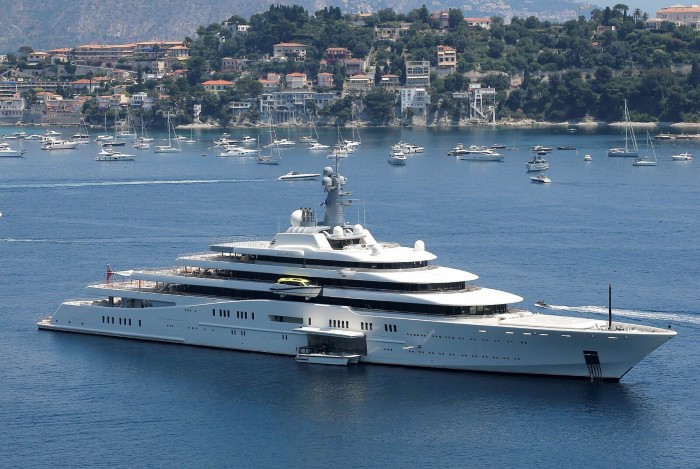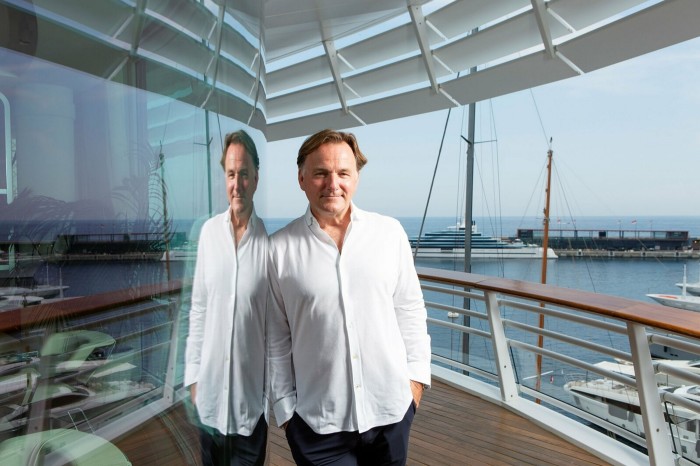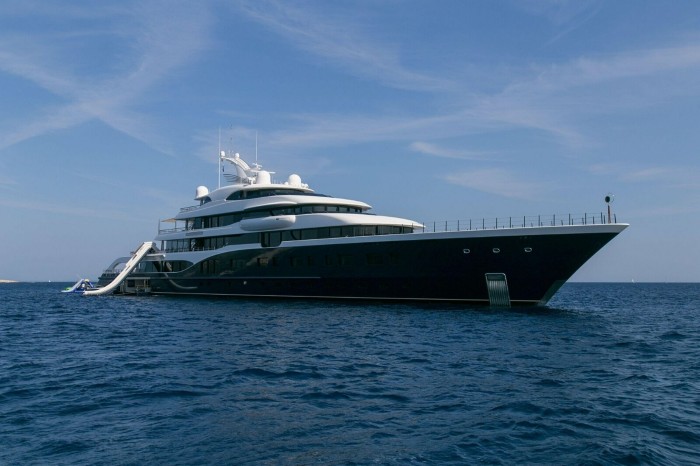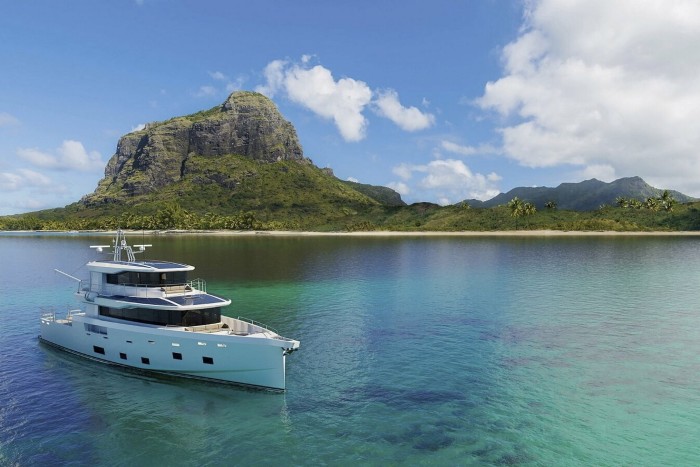Superyachts aim to go green — but at what cost?

Roula Khalaf, Editor of the FT, selects her favourite stories in this weekly newsletter.
It is hard to think of a more visible manifestation of great wealth and excessive consumption than a superyacht, as Russian oligarchs have discovered to their cost, following Vladimir Putin’s invasion of Ukraine in February.
As western governments began detaining these very obvious luxury assets at harbours and shipyards around the world in successive rounds of economic sanctions aimed at Moscow, the targeted billionaires directed crews to steer the vessels to safe havens such as the Maldives in the Indian Ocean or Turkey in the Mediterranean. Roman Abramovich’s 163-metre Eclipse, one of the world’s largest superyachts and estimated to cost more than $1bn, found refuge in the Turkish port of Marmaris.
Long before the latest Ukraine war, however, the superyacht industry faced a problem unrelated to any support the ships’ wealthy owners may have provided to warmongering authoritarian regimes: their impact on the environment and the impression they gave that the rich could not care less about climate change.
Most superyachts — typically defined as a leisure vessel more than 30 metres or 100ft in length — are essentially motor vessels like small cruise liners, catering to proprietors or charterers and a few pampered guests. The biggest have helicopter pads, swimming pools and gyms as well as luxury suites. Some even have mini-submarines.

Very few are sailing yachts, and most of them consume vast quantities of diesel. Only now are manufacturers starting to develop new technologies such as hydrogen-powered electric propulsion that will cut emissions.
In the meantime, building the boats, operating them and, eventually, scrapping them all have a damaging effect on the environment. The same is true of aircraft and cars, but the very visibility of superyachts in tourist hotspots, makes their ecological footprint an increasingly sensitive topic. The global fleet has grown more than sixfold since 1985 to reach more than 5,200, according to Superyacht Times. And the fleet cruises the world’s vulnerable oceans.
“For sure, now it’s really high up the agenda — there’s been a fundamental shift,” says Monaco-based superyacht designer Espen Oeino, who reckons it is only in the past few years that most proprietors have really started to pay attention to yacht emissions. Clients ask him what can be done to reduce energy consumption onboard, both for propulsion and for the so-called “hotel load” of air-conditioning and other services, and even how to build the boat in the first place in a responsible way.

Rob Doyle, another naval architect who designs superyachts and is based in Kinsale in Ireland, agrees that more owners are beginning to take notice of the need to reduce carbon emissions and protect the environment, though many are still concerned about the cost. “There is still a huge amount of greenwashing,” he says. “You look at the magazines and you’ll never see a bad superyacht.”

And bad they often are. Research by anthropologists Beatriz Barros and Richard Wilk of Indiana University into the carbon footprints of the super-rich found that yachts contributed an outsized share of the carbon emissions of the billionaires who own them — far more than their private jets or mansions.
For former Chelsea Football Club owner Abramovich, for example, of the 31,200 tonnes of CO₂ equivalent he is calculated to have emitted in 2018, no less than 22,400 tonnes came from his yachts. Yacht emissions for Bernard Arnault, owner of LVMH and France’s richest man, accounted for nearly 9,000 tonnes of his total of 10,400 tonnes.
There are other ways for the wealthy to be embarrassed by their superyachts. Dutch shipyard Oceanco is facing resistance from angry locals after asking the city of Rotterdam to temporarily dismantle the old Koningshaven Bridge so that Amazon founder Jeff Bezos’s new three-masted vessel — this one is a sailing yacht costing hundreds of millions of dollars — can reach the port and the open sea.

But the impact on the climate is still the environmental whale in the room for yacht owners, builders and designers: Bill Gates and Elon Musk are both big carbon emitters, but their 2018 numbers were much lower than those of their fellow billionaires because they did not have yachts, the Barros-Wilk paper showed.
The accelerating effort to green superyachts reflects similar moves in the aircraft and vehicle industries to adopt new technologies and systems that help to reduce or eliminate carbon emissions and other pollution.
For superyacht designers and builders, the process starts with the shape of the hull or hulls, because there are few things so wasteful of energy as pushing a heavy metal or composite vessel through a fluid as dense as water. For both Oeino and Doyle, this search for what Oeino calls the “geometry of an easily driven hull” means looking at multihulls (catamarans or trimarans) for the next generation of big yachts, because they are designed to skim along the surface of the sea rather than laboriously plough through it, even if there are obvious constraints on weight and what you can do with the interior space.

Next, propulsion. There are already diesel-electric boats in service, which use diesel generators running at optimum revolutions (more economical, less polluting) to power electric motors, and, in future, the idea is to run the electric motors with the output from hydrogen fuel cells.
Then there is the electricity needed for the yacht’s hotel load, principally air-conditioning and the making of fresh water from seawater, but also lights and other electrical systems. Solar panels can produce some power but rarely enough even to run a present-day superyacht at anchor, so to charge batteries and run the boat, some other form of carbon-free electricity generation is needed to replace the diesel generators widely in use today.
For Barros and Wilk, none of this can justify owning any kind of superyacht. They write: “While many billionaires have taken pro-environmental actions in their personal lives or their corporate connections or donate money to climate change organisations and purchase carbon offsets, none of these actions actually ‘cancels out’ their total emissions. A 90-metre yacht can be touted as energy efficient or environmentally friendly but, as critics of ‘eco-chic’ point out, it is still a huge waste of resources, a frivolous luxury in a warming world.”
But the industry is trying. Doyle’s answer, developed by his own firm and Van Geest Design, is Domus (“home” in Latin), a project for a 40-metre sailing trimaran described as “the first truly zero-emission yacht” over 750 gross tonnes, which would generate electricity to charge its batteries from solar panels, hydrogen fuel cells and its own propellers acting as dynamos when the boat is sailing.
“It came out of a conversation we had with a client,” says Doyle. “We proposed this project with fuel cells, and regenerative sailing. It’s silent . . . people just want to listen to the water and the wind coming across and not have the hum of generators or the whiff of diesel.”
Hydrogen propulsion is in its infancy for mass transport. The gas is difficult to store, though it can be made from methanol, and there is, as yet, no distribution network for the fuel. But the interest in hydrogen is just one sign of how the yacht industry is hunting for ways to lower emissions in the years ahead as the pressure from regulators — and public opinion — increases.
Oeino notes that in some places, including the World Heritage Site fjords such as Geirangerfjord in his native Norway, rules limiting emissions are already in place and becoming stricter, and will help to force the pace of the greening of ships and yachts.
The first systems for big yachts to be fully powered by renewables are likely to be the tenders, the smaller boats that ferry people to and from the shore, which are already starting to shift to electric propulsion, and the equipment that contributes to the hotel load when the ship is stationary. Hotel loads can, in any case, be reduced by sensible design and operation, given that indoor superyacht spaces are heavily air-conditioned all the time despite owners and guests spending a huge amount of their time outside, on deck.
Transocean travel with zero emissions is a much bigger ask, says Oeino. “A lot of stuff is already being implemented, but the full electric big yacht with zero emissions is still not a reality,” he explains, because it is impossible to store or produce enough energy onboard.
“It will be a combination of things that will bring us all to lower emissions and eventually zero emissions.”
‘Yachts for science’ can be a breakthrough for explorers

For yacht owners who feel guilty not only about their environmental footprint but also about how little they use their expensive boats, Rosie O’Donnell has the perfect solution: Yachts for Science.
YFS, which its co-ordinator O’Donnell describes as “a dating agency, almost like a Tinder for the sea”, is a platform to match idle yachts and their crews with scientists in search of a vessel that can reach remote areas and allow them to research everything from coral reefs and manta rays to great white sharks. In some cases, the owners and their families like to be on board for the ride.
“It’s for people who want to be a bit philanthropic so they have got something more to talk about than sitting on the back of their boat in St Tropez drinking cocktails,” says O’Donnell. “It’s about making the ownership more worthwhile.”
The idea of YFS fits with the trend among yachtowners to commission robust so-called expedition or explorer yachts that can travel long distances, to the Antarctic for example, rather than being satisfied with something that will buzz at high speeds around the resorts of the Mediterranean or the Caribbean.
“The yachting industry is always looking for ways to reinvent itself,” says Dominic Byrne of Arksen Marine, a builder that backs YFS and is building a new range of high-tech motor yachts. “People are looking to go further afield, and they are looking to do it in an eco-friendly way as much as possible.”
This article is part of FT Wealth, a section providing in-depth coverage of philanthropy, entrepreneurs, family offices, as well as alternative and impact investment
Climate Capital

Where climate change meets business, markets and politics. Explore the FT’s coverage here.
Are you curious about the FT’s environmental sustainability commitments? Find out more about our science-based targets here
Comments